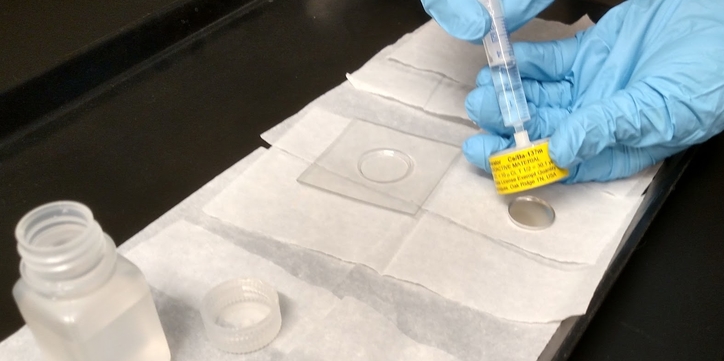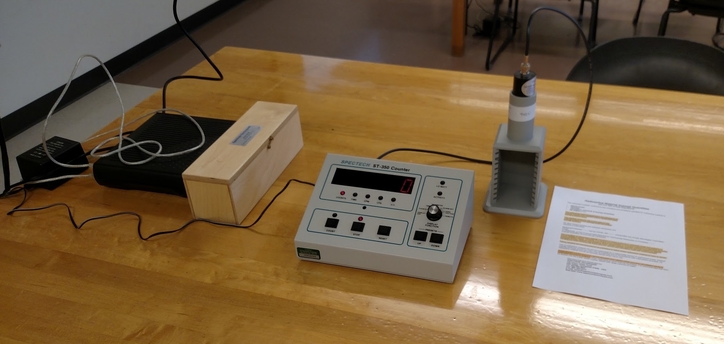
Radiation Safety
Types of Radiation sources used at St. Norbert College.
CS/Ba-137m Isotope Generator - by Spectrom Technologies
The Cs/Ba-137m Isotope Generator is designed to demonstrate the properties of radioactive decay.
This product is exempt from USNRC and State licensing and requires no special handling, storage or disposal requirements. A small quantity (<10 micro Ci.) of radioactive Cs-137 is bound on a special ion exchange medium.
The parent Cs-137 isotope beta decays with a 30.17y half-life to produce Ba-137m which in turn decays with a 2.55 min. half-life, generating a 661.6 keV gamma ray emission. This gamma ray may be readily detected using a GM or scintillation radiation detector.
Other types of Radiation Exposure
All of us are exposed to radiation every day, both from natural sources such minerals in the ground, and from man-made sources such as medical x-rays. According to the National Council on Radiation Protection and Measurement, the average annual radiation dose per person in the U.S. is 620 millirem (6.2 millisieverts). The pie chart below shows the sources of this average dose.
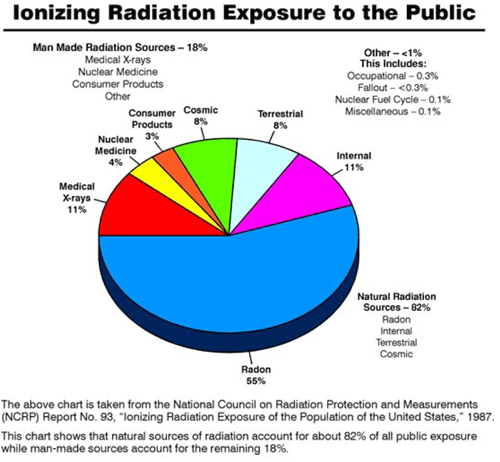
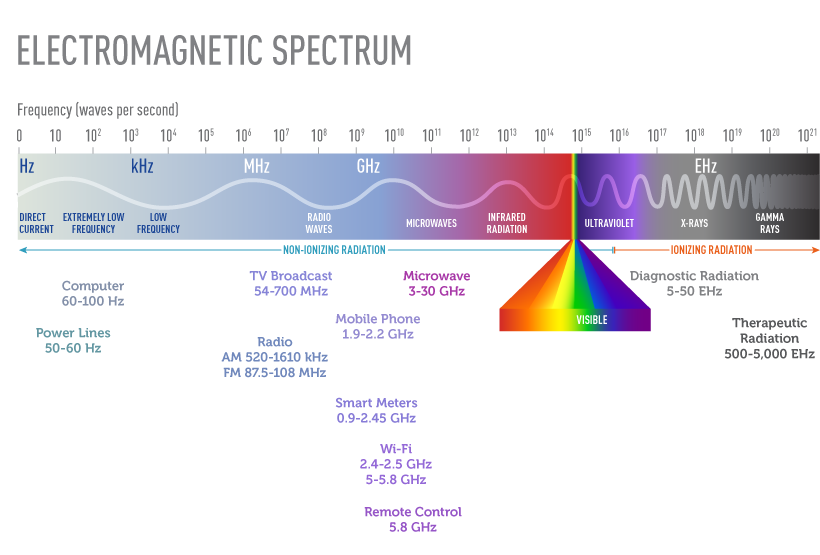
Hertz are commonly expressed in multiples: kilohertz (10^3 Hz, kHz), megahertz (10^6 Hz, MHz), gigahertz (10^9 Hz, GHz), terahertz (10^12 Hz, THz), petahertz (10^15 Hz, PHz), exahertz (10^18 Hz, EHz), and zettahertz (10^21 Hz, ZHz).
From <https://en.wikipedia.org/wiki/Hertz>
Radiation Safety
Sealed sources are used in a wide variety of occupational settings and under differing regulatory/licensing structures. This report will provide comprehensive guidance on the radiation safety aspects of sealed radioactive sources from “cradle to grave.” Recommendations will be provided on the definition of a sealed radioactive source, including design characteristics that should be considered. Guidance will be provided in the safe handling, tracking and control of sealed sources.
The report will also present a set of “lessons learned” regarding what has gone wrong with sealed sources, what caused those events, and what could be done to prevent them in the future. Example procedures for confirming inventories, leak testing, labeling, safety, training, periodic inspection, and emergency response may also be provided.
Check out the chart below to see what radiation exposure does to the human body; the symptoms of radiation exposure at different exposure levels, and the time to symptom onset.
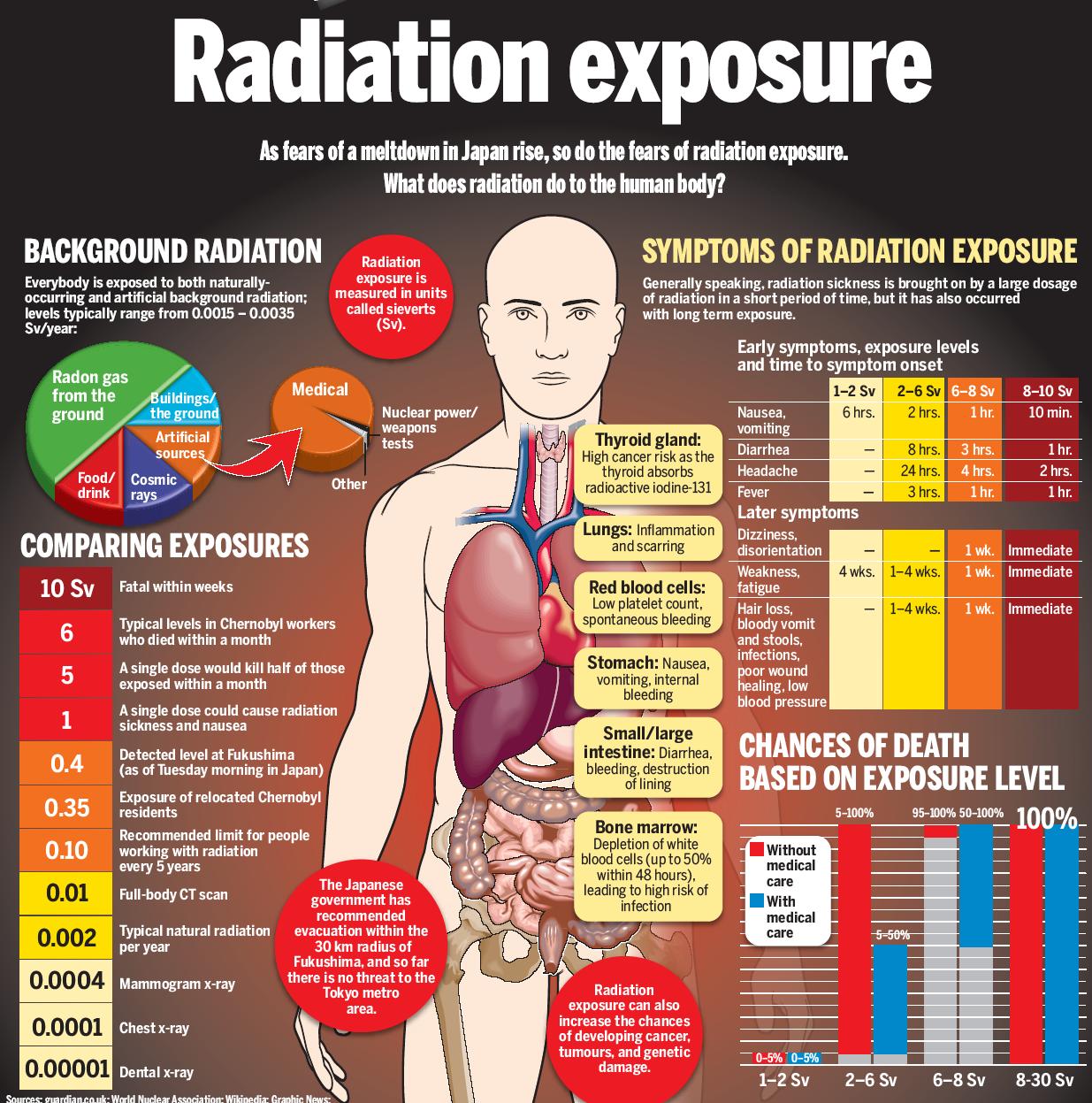
Figure reprinted with permission of the National Council on Radiation Protection and Measurements.
Half of our average dose comes from natural background sources: cosmic radiation from space, naturally occurring radioactive minerals in the ground and in your body, and from the radioactive gasses radon and thoron, which are created when other naturally occurring elements undergo radioactive decay. Another 48 percent of our dose comes from medical diagnostics and treatments.
Ionizing Radiation - enough energy to detach electrons from atoms, process of converting a stable atom or molecule into a charged one through the gain or loss of electrons. Ionizing radiation is produced by the natural decay of radioactive material.
The three types of particle radiation include Alpha, Beta, and Neutron.
Alpha radiation - the major hazard is the potential for internal damage;
Beta particles cannot penetrate the body to reach internal organs;
Neutron Radiation, neutrons do not have a charge.
There are two types of Electromagnetic Radiation, Gamma radiation and X-rays;
Biological effects of radiation - are attributed to the ionization process that destroys the capacity for cell reproduction or division or causes cell mutation.
Table 26.1 Acute Dose (Rad) Effects,
|
Rad |
Effect |
|
0-25 |
No observable effect |
|
25 -50 |
Minor temporary blood changes |
|
50-150 |
Possible nausea and vomiting and reduced white blood cells. |
|
150-300 |
Increased severity of above and diarrhea, malaise, loss of appetite. Some death |
|
300 - 500 |
Increased severity of above and hemorrhaging, depilation. LD50 at 450-500 rad. |
| >500 |
Symptoms appear sooner. LD 100 at approximately 600 rad. |
Source: U.S. Department of Labor (OSHA), Introduction to Ionizing Radiation -Lecture Outline, http://www.osha.gov/SLTC/radiationionizing/introionizing/ionizinghandout.html, p.4
Severity depends on the dose. Death usually results from damage to bone marrow or intestinal wall.
Critical organs:
Organs that are generally most susceptible to radiation damage include lymphocytes, bone marrow, gastrointestinal cells, gonads, and other fast-growing cells.
Table 26.2 Radiation Unit Description. Severity depends on the dose.
|
Usage |
Unit |
Description |
|
Activity |
Curie (Ci) |
The number of atoms disintegrating per unit of time. 1 Ci =3.7 x 10 to the 10th power |
|
Dose |
rad |
Radiation absorbed dose, 1 rad = 100 erg/g, |
|
Biological Dose |
Radiation equivalent to man (rem) |
Dose equivalent Biological effect on a person varies with different types of radiation Rem=#rads x QF (quality factor) |
|
Biological Dose |
Sievert (Sv) |
1 Sv = 100 rem |
Online conversion of Sv to rems
https://www.convert-me.com/en/convert/radiation/rrsievert.html?u=rrsievert&v=6
Types of radioactive Decay
As a part of the natural process, radioactive materials spontaneously emit various combinations of ionizing particles (alpha and beta) and gamma or x-rays of ionizing radiation to become more stable.
* https://study.com/academy/lesson/radioactive-decay-definition-formula-types.html
https://www.wikihow.com/Calculate-Half-Life
Contact Info
Mark Musser, Chemical Hygiene Officer (CHO)920-403-4019
mark.musser@snc.edu





